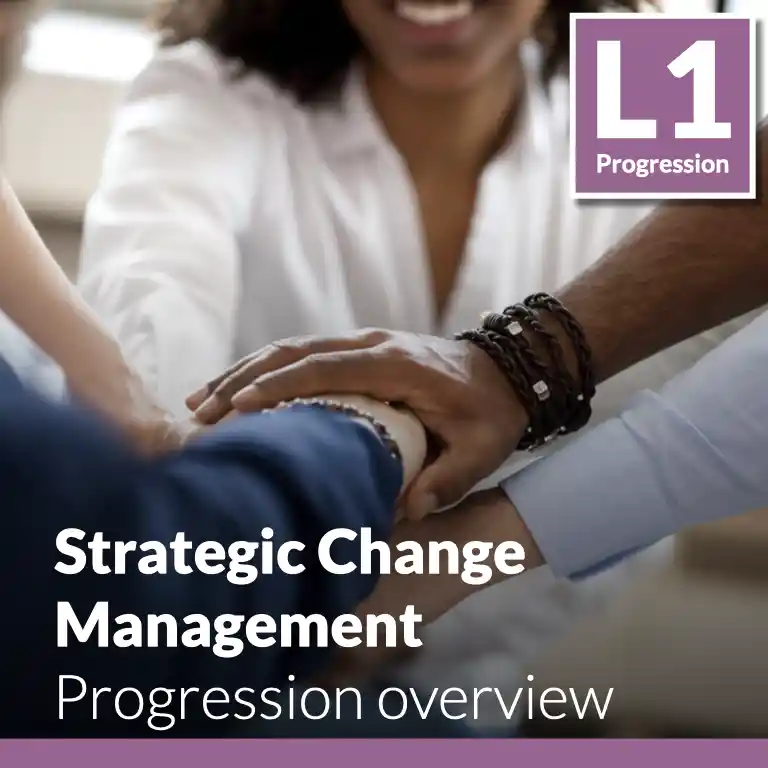Enjoy instant access to a scalable system of proven practices and execution-ready tools. Built to launch strategic HR programs 5X faster!
✓ Enjoy platform access
✓ Create your HR roadmap
✓ View open content in library
✓ Access dozens of practices:
⤷ The HR Strategy program
⤷ Explainers and deep dives
⤷ Supplemental guides
⤷ Insight articles
⤷ Weekly best practices
⤷ And more!
100% Free. No credit card required.
This guide is part of a progression set comprised of Core, Advanced, and Emerging Strategic Change Management practices.
Simply put, Change Management – sometimes called Organizational Change Management, Behavioral Change Management, or Change Enablement – is a set of activities to help people understand why changes are being implemented, communicate how different people or groups will be impacted, and prepare them to be successful so that the company can minimize resistance to change, garner support for change, and accelerate value realization. It is a structured intervention designed to create awareness of the change being implemented and support the ability of targeted employees to implement it successfully in the flow of their daily work. Change can involve anything that alters one or more work-related processes, be it related to one’s job/task assignments or administrative requirements. Examples of change can include the introduction of new or improved business or administrative tactics, processes, practices, or technologies.
Depending on the degree of change required, there can be an entire change management team, one change manager, or only an initiative manager executing the change management activities. The change curve is a popular diagram with many iterations to depict how people experience change. It was first introduced in the 1960s by Elisabeth Kubler-Ross to explain the grieving process. She further asserted that it could be applied to any dramatic life-changing situation. The core stages of the model are often slightly modified for use in work environments and used as the basis for the popular change management models that exist today.
Regardless of the type of change, most people react similarly. Different people progress through the curve at different paces. Effective change management programs are designed to progress stakeholders through the curve as quickly as possible to minimize business disruption and accelerate value realization from the change initiative. These core practices are effective for changes that impact a relatively small number of people and have a low to medium degree of impact. They best apply to changes such as updates to an existing business process or establishing a new specialized group in a single function.
Driving and sustaining organizational change can be quite difficult. Each impacted person or stakeholder group can have widely varying perspectives on why change should or should not happen. Benefits for one group can have negative impacts on another. Helping both internal and external stakeholders understand and adopt new ways of working requires a thoughtful and targeted strategy.
Studies show that effective change management strategies increase an initiative's success rate and result in faster value realization. According to market research, “Initiatives with excellent change management are six times more likely to meet objectives than those with poor change management.” In fact, by simply moving from “poor” to “fair,” change management increases the likelihood of meeting objectives threefold.
With the rapid expansion of new technologies and a desire to improve process efficiencies and lower business costs, the pressure to create new ways of working and creating value for the company, its customers, and various stakeholders is substantial. Successful adoption of any changes an organization might make in a year alone can “make or break” the required investments. Change management is designed to increase the likelihood of successful implementations and employee acceptance of the related changes to how they perform their work, improve their productivity and performance, or conduct administrative tasks.
This set of guides will help design and execute a fit-for-purpose change management strategy to understand the true impact of change, engage stakeholders, build support through thoughtful communications, and design an effective training program.
Adopting these practices yields a clear understanding of the proposed change and impacted audiences, as well as the gaps that need to be filled and the barriers that need to be overcome for successful acceptance and implementation. That, in turn, provides input to developing a change mitigation plan that helps prioritize the activities required to stimulate user acceptance and use of the change. A formal assessment of the stakeholders and their needs leads to developing a multi-pronged communication and engagement plan to drive a clear understanding and adoption of the new process or tools. Finally, a formal assessment of training needs yields a plan of action complete with a detailed curriculum. Actual training programs are then scheduled and delivered (live or online, instructor-led or automated). Evaluation criteria and measures of learning and delivery effectiveness are included during or after course completion, and the degree of end-user knowledge and skill acquisition are assessed.
Understanding how an initiative will impact the organization and specific stakeholder groups or people to determine where the most change support is needed and prioritize activities and spend.
Creating effective communication and engagement strategies that build confidence and employee embracing of change initiatives.
Establishing an effective training program that ensured that stakeholders are able to operate in the new ways of working while minimizing business disruption.

Enjoy instant access to a scalable system of proven practices and execution-ready tools. Built to launch strategic HR programs 5X faster!